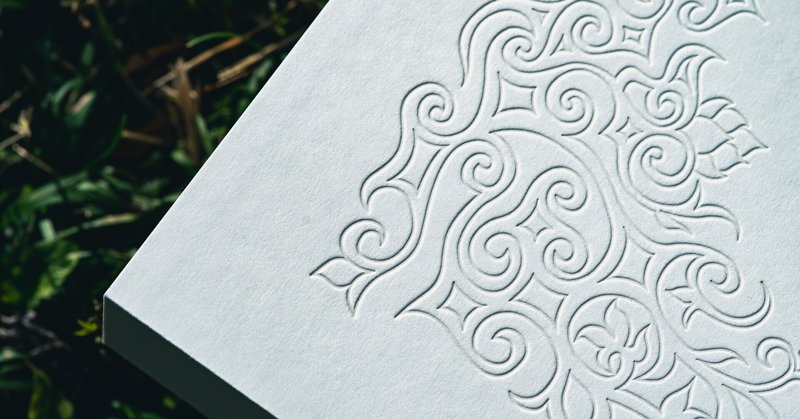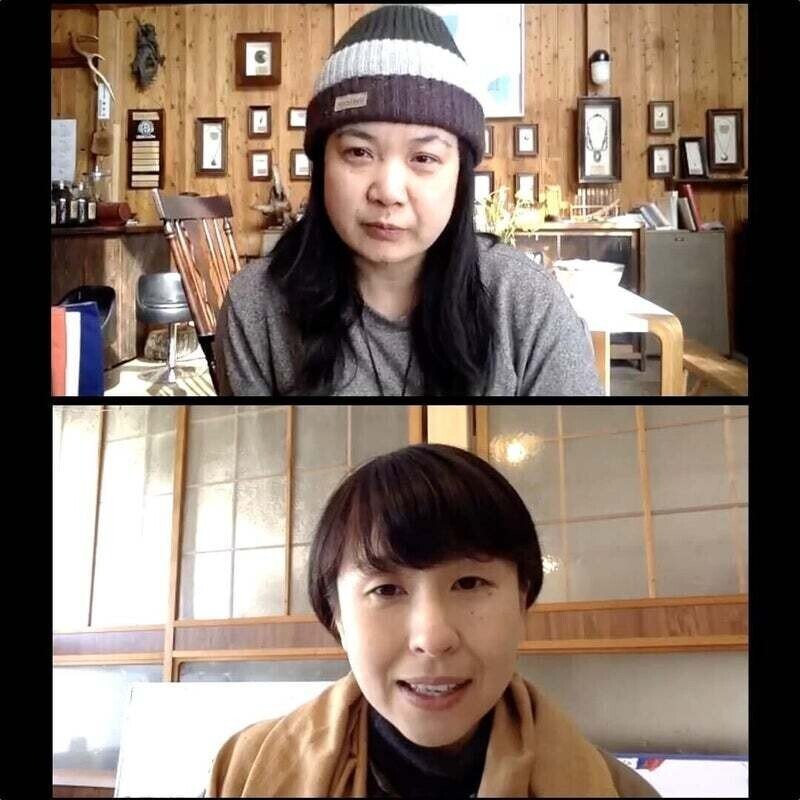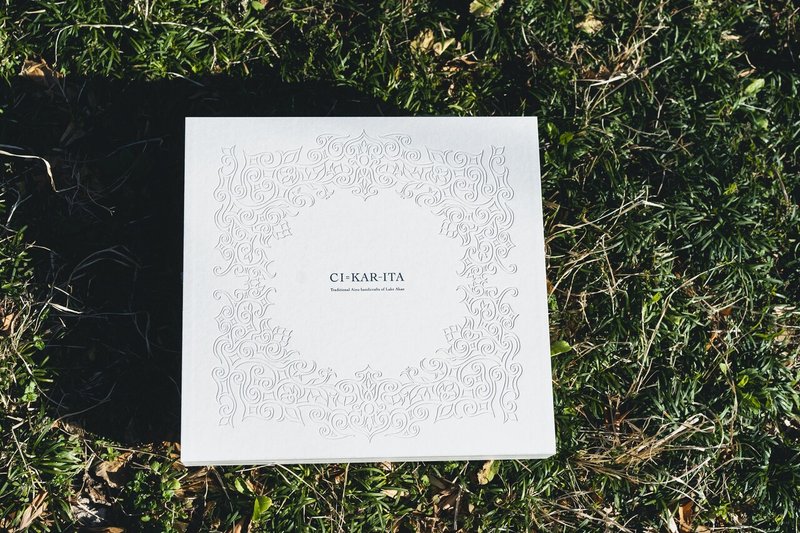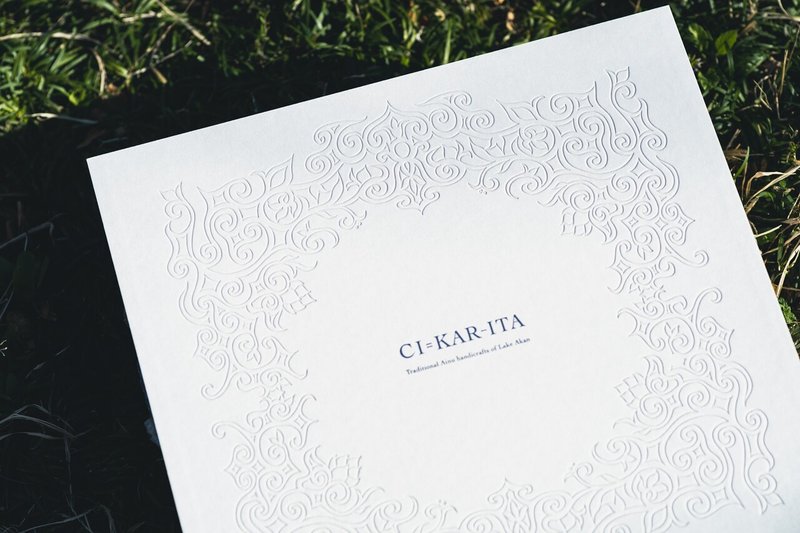
Raising Children in Place, Passing on A Way of Seeing and Learning From Children: A Conversation on Generations and Nature with Emi Shimokura (handicrafter) and Kaori Hirano (Itoshiro Yōhinten)
Ainu patterns born of nature and spun from history and fashion that give local history a new lease on life. How do people develop an eye for nature and move towards a new craft while staying local. In this conversation, we consider the relationship between nature and the human that emerges from locality and history in conversation with two people who are both artists and mothers.

Above: Emi Shimokura (handicrafter).Steeped in Ainu culture since early childhood, Shimokura shares the enchantment of Ainu folk song as part of sister group ‘Kapiw & Apappo’ while also producing original work at her studio, café & gallery KARIP. She is married to Hiroyuki Shimokura, who also works as a jeweller in Akanko.
Below: Kaori Hirano (Owner, Itoshiro Yōhinten). Born in Gifu Prefecture, in her student days Hirano studied cultural anthropology and conducted research on the world of traditional Cambodian traditional textiles. In 2011 she moved to the mountain village of Itoshiro in Gifu Prefecture, where she opened her shop Itoshiro Yōhinten in 2012. She was fascinated by the wisdom and techniques of local traditional clothing such as Tatsuke and Hakama trousers. She started making them and now gives workshops where she shares the technique with others.
May I begin by asking you both to introduce yourselves?
Emi Shimokura (S): I run Café & Gallery KARIP near Akanko in Hokkaido together with my husband, who is a jeweller. I got back in touch with traditional crafts when I came back to Akanko. At the moment I am making merchandise with textiles and materials made from bulrushes.
I was raised in Akanko so I was surrounded by people who are involved in craft. I had some experience with woodcarving, watched my mother doing embroidery and learned handicrafts from my grandmother. Sometimes I can still remember feelings and smells from that time.
Kaori Hirano (H): I moved to the hamlet of Itoshiro in Gifu Prefecture in September 2011. In May 2012 I started my shop Itoshiro Yōhinten, where I make clothes that are rooted in local history, like the Tatsuke trousers that are used for agricultural work. I began working alone at my sewing machine with my baby strapped to my back. Then in 2017, I started a company that I now manage with some friends. After leaving Tokyo, I longed to live close to nature and I moved to Itoshiro because I had some connections here.

▲Tatsuke made in Itoshiro Yōhinten, the shop Hirano manages. The cotton is died with local indigo.
Can you tell me how you came to relocate from Tokyo to where you live now?
S: I lived in the Tokyo area until 2011 but the Great East Japan Earthquake Disaster prompted me to move back to Hokkaido. Hokkaido is the place where I was born and raised and I always wanted to live here with my family. I also I wanted to live close to the earth in a place where nature is abundant.
H: I also wanted to raise my children in close contact with the earth. When I was a child there were still vacant lots and gravel paths near my family home so there were lots of places to play. But now the whole area has been buried under asphalt. When it came to building my own life, I knew I wanted to be closer to nature.
You are both involved in crafts that were born in your local area. Have you have inherited anything from the older generation in the places where you live?
H: The Tatsuke trousers I make were once used for agricultural work but people had stopped wearing them. I learned about them from a local grandmother. The first step was reshaping them.
Back when I was a student, I was really interested in people’s lifeways and the meanings behind them. I studied cultural anthropology. When I redesigned the Tatsuke as a product, I did so with the same attitude I brought to collecting life histories and doing fieldwork. I saw it from the perspective of how to bring old things and traditions to life in the present day.
S: I learned from my elders too. For rush weaving, I use bulrush leaves which we call sikina in the Ainu language. This isn’t the sort of material you can buy. At first, my aunt would share some of her material with me. Later I had the opportunity to go and gather them myself. That’s when I first realised what hard work it is.

▲A bag made by Shimokura using a rush weaving method Ainu people employ for everyday use.
You are both raising children at the same time as making craft aren’t you?
S: When Kaori was speaking before, I thought about how fortunate she is to have such a great place for raising children. When my children were small and we were living in Tokyo, I found it really difficult to keep up with housework, childminding, work and all the rest of it. It was hard to make any time for myself.
My auntie once told me that when her children were small, she sometimes climbed into their cot herself to work. The children on the outside would be reaching their hands through the railings to try and touch their mother. Mothers who do craft are all frenetic aren’t they!
H: Unlike Emi, I’m a blow-in, so I haven’t inherited anything much from my family. But I have been given so much by the people of this area. I also learn a lot from my children, even without asking them directly. The children tell me things they learn from the principal of their daycare, who is a local. When we are walking to and from school together, they teach me about different varieties of plants and their uses. This knowledge can sometimes be applied to dyeing and making clothes.
S: I have also learned a lot from raising children. Our local preschool has a policy of trying to foster interaction with nature. They have a lot of events that are rooted in the local area, like playing with sleds and fishing for pond smelt. The parents also participate. This also reconnects me to this land. I remember scenes from my childhood and other things I had forgotten.
Can you tell me about something you enjoy or about some of the challenges of making things in your local natural environment?
H: Going into the mountains and touching the earth is a real joy. These experiences are so rich. Ordering materials via express delivery means you can use them straight away. It’s very convenient but only half the fun. The process of using plants from the local area really makes you feel that you are surrounded by abundant nature. Because I am so blessed, I want more and more to turn it into something.
I reckon that if you don’t do something unique to your place, then it doesn’t mean much. These days, if you have the money, you can procure anything from anywhere. But that’s why I think it would be a waste for us not to keep on practicing our unique crafts. I want to practice a craft that says something about this place through my dyeing and through making Tatsuke.
S: Gathering materials is tough because it’s hard physical labor. There are so many varieties of grasses and sometimes I gather the wrong ones by mistake. Even so, sometimes something I harvested by mistake leads me to make a new work, so there are discoveries too. Even if you don’t go out with the purpose of harvesting, going into the forest naturally releases tensionff. Without a doubt, my daily life is made richer by the ideas and images that emerge from the things I take from nature.

▲Shimokura was responsible for designing the patterns used in this packaging for ‘Chi-Kar-Ita’. The box contains work by another artist. (Photo: Yuri Manabe)
Finally, Ms Shimokura, can I ask about your ‘Chi-Kar-Ita’ piece.
H: In the Ainu language, ‘Chi-Kar-Ita’ means ‘a dish we made’. I made the packaging together with the designer Kumiko Noda. I took care of the design for the Ainu pattern. When you hear the words ‘folk art tray’, they conjure up a heavy, primitive image. For the packaging, we took the opposite approach. Kumiko was looking for simplicity and I followed her suggestions closely.
The Ainu pattern on the outside is not a reproduction of a traditional pattern. I tried to arrange it after my own fashion by inserting different elements. The feeling is of a white clover flower, one you picked while taking a walk, popping out from within the Ainu pattern.
H: When I first saw it, I thought it looked completely different from any Ainu pattern I know. As you were talking, I felt like I could really feel the way you see the world. It’s a sense of freedom and a sensitivity.

▲During our conversation, Shimokura joked that she would like to try using it as a jewellery box (Photo: Yuri Manabe).
Shimokura shares her love for the connection between place, creativity and family. Hirano is uncovering something indispensable from local history. While raising the next generation, both artists look to nature with a view to the present and an eye for the future. In a nature that is ever-changing, people spin histories while making craft.
Translation: Alexander Brown
この記事が気に入ったらサポートをしてみませんか?
